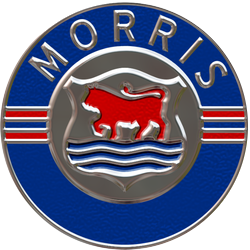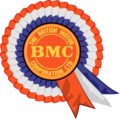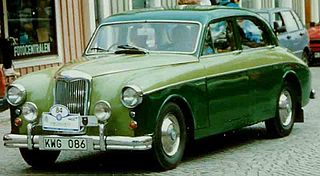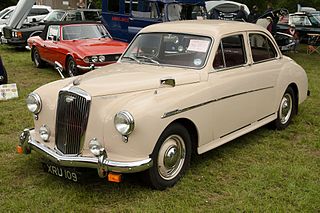
The Mini is a small, two-door, four-seat car produced by the British Motor Corporation (BMC) and its successors, from 1959 until 2000. Minus a brief hiatus, original Minis were built for four decades and sold during five, from the last year of the 1950s into the last year of the 20th century, over a single generation, as fastbacks, estates, and convertibles.

Morris Motors Limited was a British privately owned motor vehicle manufacturing company formed in 1919 to take over the assets of William Morris's WRM Motors Limited and continue production of the same vehicles. By 1926 its production represented 42 per cent of British car manufacture—a remarkable expansion rate attributed to William Morris's practice of buying in major as well as minor components and assembling them in his own factory.

The British Motor Corporation Limited (BMC) was a UK-based vehicle manufacturer formed in early 1952 to give effect to an agreed merger of the Morris and Austin businesses.

Riley was a British motorcar and bicycle manufacturer from 1890. Riley became part of the Nuffield Organization in 1938 and was merged into the British Leyland Motor Corporation in 1968. In July 1969 British Leyland announced the immediate end of Riley production, although 1969 was a difficult year for the UK automotive industry and many cars from Riley's inventory may have been first registered in 1970.

The Morris Minor is an economy car produced by British marque Morris Motors between 1948 and 1971. It made its debut at the Earls Court Motor Show, London, in October 1948. Designed under the leadership of Alec Issigonis, more than 1.6 million were manufactured in three series: the Series MM, the Series II, and the 1000 series.

The BMC C-Series is a straight-6 automobile engine produced from 1954 to 1971. Unlike the Austin-designed A-Series and B-Series engines, it came from the Morris Engines drawing office in Coventry and therefore differed significantly in its layout and design from the two other designs which were closely related. This was due to the C-Series being in essence an enlarged overhead valve development of the earlier 2.2 L Straight-6 overhead camshaft engine used in the post-war Morris Six MS and Wolseley 6/80 from 1948 until 1954, which itself also formed the basis of a related 1.5 L 4-cylinder engine for the Morris Oxford MO in side-valve form and the Wolseley 4/50 in overhead camshaft form. Displacement was 2.6 to 2.9 L with an undersquare stroke of 88.9 mm (3.50 in), bored out to increase capacity.

The Riley RM is a series of executive cars and compact executive cars that were made by Riley Motors from 1945 until 1955. They were the last models developed independently by Riley before its parent company, Nuffield, merged with Austin to form BMC. The RM series was produced in Coventry until 1949, when production moved to the MG works at Abingdon. Until 1952, models were marketed as the Riley 1½ Litre and the Riley 2½ Litre. the term RM has been used retrospectively to encompass models produced before 1952.

The Riley Pathfinder is an automobile which was produced by Riley Motors Limited in the United Kingdom from 1953 to 1957. It was first presented at the London Motor Show in October 1953 and replaced the RMF as Riley's top-line model.

The Riley Two-Point-Six is an automobile produced by British Motor Corporation Limited (BMC) from August 1957 until 1959. It replaced the Pathfinder as Riley's flagship model when it was announced on 23 August 1957. While its predecessor retained the renowned Riley four-cylinder twin-cam cross-flow engine, coil rear suspension and gearbox, the Two-Point-Six was virtually identical to the Wolseley Six-Ninety Series III. It featured both monotone and duotone paintwork, as did the last of the Pathfinders. As per the Wolseley Six-Ninety Series III, right hand drive cars with a manual gearbox had a right hand gear lever; LHD cars a left hand gear lever. An automatic transmission and an overdrive for the manual gearbox were available as options.

The Riley One-Point-Five and similar Wolseley 1500 are cars produced by Riley and Wolseley respectively from 1957 until 1965. They utilised the Morris Minor floorpan, suspension and steering but were fitted with the larger 1,489 cc (90.9 cu in) B-Series engine and MG Magnette gearbox.

The MG Magnette is a car that was produced by MG between 1953 and 1968. The Magnette was manufactured in two build series, the ZA and ZB of 1953 through to 1958 and the Mark III and Mark IV of 1959 through to 1968, both using a modified Wolseley body and an Austin engine.

Wolseley Motors Limited was a British motor vehicle manufacturer founded in early 1901 by the Vickers Armaments in conjunction with Herbert Austin. It initially made a full range, topped by large luxury cars, and dominated the market in the Edwardian era. The Vickers brothers died and, without their guidance, Wolseley expanded rapidly after the war, manufacturing 12,000 cars in 1921, and remained the biggest motor manufacturer in Britain.

The Wolseley 15/50 was an updated version of the Wolseley 4/44. The main change was the engine; the 4/44 used a pre BMC Morris XPA unit and after the MG TF stopped production it was the only car still fitted with it. To rationalise production the 15/50 was launched with the BMC B-series engine fitted. Much of the design was shared with the MG Magnette, although some of the panels of the MG Magnette ZA/ZB are not interchangeable with those of the Wolseley 15/50, as stated in Practical Classics.

The Wolseley 4/50 and similar 6/80 were Wolseley Motors' first post-war automobiles. They were put into production in 1948 and were based on the Morris Oxford MO and the Morris Six MS respectively. The 4-cylinder 4/50 used a 1476 cc 50 hp version of the 6/80 engine, while the 6/80 used a 2215 cc 72 hp straight-6 single overhead cam.

The Wolseley 15/60 is an automobile which was produced from 1958 to 1961, and then, as the Wolseley 16/60, from 1961 to 1971. The 15/60 was the first of the mid-sized Pinin Farina-styled automobiles manufactured by the British Motor Corporation (BMC). Launched in December 1958 as part of BMC's Wolseley brand, the design would eventually be shared with seven other marques. All of the cars were updated in 1961 with a larger engine and new model designations. The Wolseley 16/60 was the last, in production until 24 April 1971.

The Wolseley 6/99 and 6/110 were the final large Wolseley cars. Styled by Pininfarina with additions by BMC staff stylists, the basic vehicle was also sold under two of BMC's other marques as the Austin A99 Westminster and Vanden Plas Princess 3-Litre. Production began in 1959 and the cars were updated and renamed for 1961. The Wolseley remained in production as the Wolseley 6/110 through to 1968.

The Austin Westminster series are large saloon and estate cars that were sold by the British manufacturer Austin from 1954, replacing the A70 Hereford. The Westminster line was produced as the A90, A95, A99, A105, and A110 until 1968 when the new Austin 3-Litre took its place. Essentially badge-engineered versions of the Farina Westminsters were also produced using the premium Wolseley and Vanden Plas marques. 101,634 Westminsters were built.

Morris Oxford is a series of motor car models produced by Morris of the United Kingdom, from the 1913 'bullnose' Oxford to the Farina Oxfords V and VI.

Morris Commercial Cars Limited is a British manufacturer of commercial vehicles formed by William Morris, founder of Morris Motors Limited, to continue the business of E G Wrigley and Company which he purchased as of 1 January 1924.

The Morris Oxford Farina is a series of motor car models that were produced by Morris of the United Kingdom from 1959 to 1971. The Farina name coming from the Italian design studio employed for styling.




















